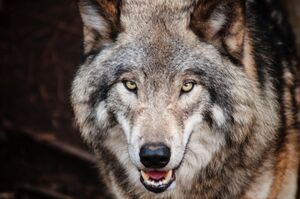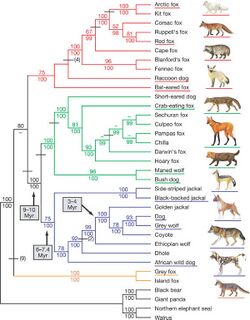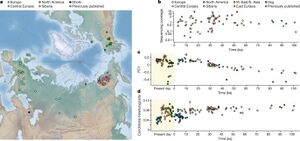Evolution of Wolves: Difference between revisions
No edit summary |
No edit summary |
||
| (7 intermediate revisions by the same user not shown) | |||
| Line 1: | Line 1: | ||
==Introduction== | ==Introduction== | ||
Wolves (Canis lupus) are | Wolves (Canis lupus) are apex predators with a long evolutionary history that has positioned them as one of the most adaptable and successful carnivores in the animal kingdom. They belong to the Canidae family, which includes domestic dogs (Canis lupus familiaris), coyotes (Canis latrans), and jackals. Known for their intelligence, social structure, and hunting prowess, wolves have evolved to thrive in diverse environments ranging from Arctic tundras to temperate forests. Their evolutionary journey reflects resilience and adaptability, as they have endured dramatic climatic shifts, ecological changes, and human influences over thousands of years. By examining their lineage, from ancient ancestors to modern apex predators, researchers have uncovered a fascinating story of genetic adaptations, natural selection, and co-evolution with other species—including humans. This journey not only highlights the importance of wolves in maintaining ecological balance but also underscores their role in shaping the evolutionary history of domestic dogs. Moreover, understanding their biology and ecology is essential for conservation efforts and for appreciating their significance in the natural world. | ||
[[Image: | [[Image:pexels-photo-682375.jpg|thumb|300px|left|Figure 1. Gray Wolf. Image courtesy of Pixabay via PBS.<ref name=" abc ">[https://www.pbs.org/wnet/nature/blog/gray-wolf-facts/]1. Schmidt A. Wolves fact sheet [Internet]. Public Broadcasting Service; 2024 [cited 2024 Dec 13]. Available from: https://www.pbs.org/wnet/nature/blog/gray-wolf-facts/ </ref>]] | ||
<br> <br> | |||
==Genetics== | |||
The lineage of wolves traces back to the Miacids, small carnivorous mammals from the late Paleocene and Eocene epochs (approximately 62–33 million years ago). Miacids are considered the ancestors of all modern carnivores, including canids. By the late Miocene (about 10 million years ago), the family Canidae had split into three subfamilies: Hesperocyoninae, Borophaginae, and Caninae, with Caninae being the direct ancestors of modern wolves. | |||
< | [[Image:Phylogeny-of-canid-speciesThe-phylogenetic-tree-is-based-on-15-kb-of-exon-and-intron.jpeg|thumb|250px|right|Figure 2. Phylogeny of canid species.<ref name="species">[https://www.researchgate.net/publication/232796615_Genome_sequence_comparative_analysis_and_haplotype_structure_of_the_domestic_dog]Lindblad-Toh, Kerstin & Wade, Claire & Mikkelsen, Tarjei & Karlsson, Elinor & Jaffe, David & Kamal, Michael & Clamp, Michele & Chang, Jean & Kulbokas, Edward & Zody, Michael & Mauceli, Evan & Xie, Xiaohui & Breen, Matthew & Wayne, Robert & Ostrander, Elaine & Ponting, Chris & Galibert, Francis & Smith, Douglas & deJong, Pieter & Lander, Eric. (2005). Genome sequence, comparative analysis and haplotype structure of the domestic dog. Nature. 438. 803-819. 10.1038/nature04338. </ref>]] | ||
The genus Canis emerged around 2–3 million years ago, marking a significant milestone in wolf evolution. Early species such as Canis lepophagus and Canis edwardii exhibited transitional features between earlier canids and the robust forms of modern wolves. One notable relative, Canis dirus (the dire wolf), coexisted with Canis lupus during the Pleistocene epoch. Dire wolves were specialized predators of large Ice Age megafauna, a diet that ultimately contributed to their extinction as their prey disappeared. Fossil evidence reveals that the evolutionary trajectory of wolves was deeply influenced by their ability to adapt to changing prey and environments, ensuring their survival through multiple climatic upheavals. | |||
Modern wolves belong to the genus Canis, which flourished during the Pleistocene. As Ice Age climates fluctuated, wolves adapted to a variety of habitats, from frigid tundras to temperate forests. Their ability to exploit diverse environments and prey allowed them to thrive across Europe, Asia, and North America. | |||
Wolves' adaptations included long legs for endurance running, powerful jaws for crushing bones, and sharp teeth for slicing flesh. Social behavior, particularly pack hunting, emerged as a key evolutionary trait. This cooperative strategy allowed wolves to take down prey much larger than themselves, such as elk, bison, and moose, ensuring their survival even in harsh conditions. Fossil records indicate that wolves were highly successful during the Ice Age, competing with other apex predators and carving out a significant ecological niche. The genus Canis diversified during this time, giving rise to species that displayed a remarkable ability to adapt to various environmental challenges, setting the stage for the modern wolf's widespread distribution. | |||
By analyzing 72 ancient wolf genomes from across Europe, Siberia, and North America, spanning the past 100,000 years, the researchers reconstructed the population history of wolves during the Late Pleistocene. Their findings reveal that ancient wolves exhibited high genetic connectivity across vast geographic ranges, allowing gene flow and resilience during periods of climatic and ecological upheaval. <ref name=" nature ">[https://www.nature.com/articles/s41586-022-04824-9#Fig1]Perri, A. R., et al. (2022). Grey wolf genomic history reveals a dual ancestry of dogs. Nature. DOI: 10.1038/s41586-022-04824-9.</ref> | |||
The study identified Siberia as a critical region for wolf evolution, contributing substantial genetic diversity to other global wolf populations. Through admixture events, Siberian wolves influenced European wolf populations, particularly after the Last Glacial Maximum (LGM). This connectivity contrasts with the isolation observed in many other large carnivores during the same period, underscoring wolves' adaptability and mobility. | |||
<ref name=" | |||
However, human expansion has led to conflicts, resulting in habitat loss, population declines, and even extirpation in some regions. | |||
Conservation efforts have focused on reintroducing wolves to areas where they were extirpated. One notable success story is the reintroduction of wolves to Yellowstone National Park. This initiative demonstrated the critical role wolves play in maintaining ecological balance. By controlling prey populations like elk, wolves indirectly contributed to the regeneration of vegetation and the restoration of riparian ecosystems.<ref name="YellowStone">[https://www.yellowstonepark.com/park/conservation/yellowstone-wolves-reintroduction/] Peglar, Tori, et al.(1995) 1995 Reintroduction of Wolves in Yellowstone.</ref> | |||
[[Image:41586_2022_4824_Fig1_HTML.jpeg|thumb|300px|right|Figure 3. Sampling Locations of Ancient Wolves across Europe, Siberia, and North America.<ref name="nature"></ref>.]] | |||
==Microbiome== | |||
Wolves consume large quantities of meat and fat, and their gut microbiomes facilitate the efficient digestion of these nutrients. Specialized bacteria such as Clostridia species play a key role in breaking down complex proteins and lipids into absorbable compounds, ensuring wolves extract maximum energy from their prey. This efficiency is particularly crucial during winter months or food shortages when prey availability is low. | |||
Certain compounds in prey animals, such as secondary metabolites or toxins, are neutralized by gut microbes. For instance, microbial detoxification enables wolves to safely consume scavenged or partially decayed prey without adverse effects. This ability not only broadens their dietary options but also reduces competition with other predators by allowing them to utilize less desirable food sources effectively | |||
Gut microbiota play a crucial role in maintaining overall health and protecting against pathogens. A healthy microbiome enhances wolves' immune responses by regulating inflammatory processes and preventing the colonization of harmful bacteria. This microbial support is essential for wolves, as their scavenging behavior exposes them to a variety of pathogens. | |||
Beyond protein and fat digestion, gut microbes contribute to synthesizing essential vitamins and short-chain fatty acids, which play a role in energy metabolism and gut health. These microbial byproducts help compensate for dietary limitations and ensure the overall well-being of wolves in diverse environments. | |||
.<ref name="microbe">[https://www.nature.com/articles/s41598-017-11770-4] Wu, X., Zhang, H., Chen, J. et al. Analysis and comparison of the wolf microbiome under different environmental factors using three different data of Next Generation Sequencing. Sci Rep 7, 11332 (2017). https://doi.org/10.1038/s41598-017-11770-4</ref> | |||
<br> | <br> | ||
==Conclusion== | ==Conclusion== | ||
The evolutionary story of wolves is one of resilience, adaptation, and interaction with humans. Their journey from ancient Miacids to apex predators highlights their ecological importance and evolutionary ingenuity. By understanding their origins and relationships with humans and the environment, we can better ensure their survival in a changing world. Wolves serve as a reminder of nature's complexity and the interconnectedness of all living organisms, emphasizing the need to protect and coexist with these creatures. | |||
==References== | ==References== | ||
<references /> | <references /> | ||
<br>Edited by | <br>Edited by Amadou Diop, student of Joan Slonczewski for BIOL 116, 2024, [http://www.kenyon.edu/index.xml Kenyon College]. | ||
<!--Do not edit or remove this line-->[[Category:Pages edited by students of Joan Slonczewski at Kenyon College]] | <!--Do not edit or remove this line-->[[Category:Pages edited by students of Joan Slonczewski at Kenyon College]] | ||
Latest revision as of 07:13, 13 December 2024
Introduction
Wolves (Canis lupus) are apex predators with a long evolutionary history that has positioned them as one of the most adaptable and successful carnivores in the animal kingdom. They belong to the Canidae family, which includes domestic dogs (Canis lupus familiaris), coyotes (Canis latrans), and jackals. Known for their intelligence, social structure, and hunting prowess, wolves have evolved to thrive in diverse environments ranging from Arctic tundras to temperate forests. Their evolutionary journey reflects resilience and adaptability, as they have endured dramatic climatic shifts, ecological changes, and human influences over thousands of years. By examining their lineage, from ancient ancestors to modern apex predators, researchers have uncovered a fascinating story of genetic adaptations, natural selection, and co-evolution with other species—including humans. This journey not only highlights the importance of wolves in maintaining ecological balance but also underscores their role in shaping the evolutionary history of domestic dogs. Moreover, understanding their biology and ecology is essential for conservation efforts and for appreciating their significance in the natural world.

Genetics
The lineage of wolves traces back to the Miacids, small carnivorous mammals from the late Paleocene and Eocene epochs (approximately 62–33 million years ago). Miacids are considered the ancestors of all modern carnivores, including canids. By the late Miocene (about 10 million years ago), the family Canidae had split into three subfamilies: Hesperocyoninae, Borophaginae, and Caninae, with Caninae being the direct ancestors of modern wolves.

The genus Canis emerged around 2–3 million years ago, marking a significant milestone in wolf evolution. Early species such as Canis lepophagus and Canis edwardii exhibited transitional features between earlier canids and the robust forms of modern wolves. One notable relative, Canis dirus (the dire wolf), coexisted with Canis lupus during the Pleistocene epoch. Dire wolves were specialized predators of large Ice Age megafauna, a diet that ultimately contributed to their extinction as their prey disappeared. Fossil evidence reveals that the evolutionary trajectory of wolves was deeply influenced by their ability to adapt to changing prey and environments, ensuring their survival through multiple climatic upheavals.
Modern wolves belong to the genus Canis, which flourished during the Pleistocene. As Ice Age climates fluctuated, wolves adapted to a variety of habitats, from frigid tundras to temperate forests. Their ability to exploit diverse environments and prey allowed them to thrive across Europe, Asia, and North America.
Wolves' adaptations included long legs for endurance running, powerful jaws for crushing bones, and sharp teeth for slicing flesh. Social behavior, particularly pack hunting, emerged as a key evolutionary trait. This cooperative strategy allowed wolves to take down prey much larger than themselves, such as elk, bison, and moose, ensuring their survival even in harsh conditions. Fossil records indicate that wolves were highly successful during the Ice Age, competing with other apex predators and carving out a significant ecological niche. The genus Canis diversified during this time, giving rise to species that displayed a remarkable ability to adapt to various environmental challenges, setting the stage for the modern wolf's widespread distribution.
By analyzing 72 ancient wolf genomes from across Europe, Siberia, and North America, spanning the past 100,000 years, the researchers reconstructed the population history of wolves during the Late Pleistocene. Their findings reveal that ancient wolves exhibited high genetic connectivity across vast geographic ranges, allowing gene flow and resilience during periods of climatic and ecological upheaval. [3] The study identified Siberia as a critical region for wolf evolution, contributing substantial genetic diversity to other global wolf populations. Through admixture events, Siberian wolves influenced European wolf populations, particularly after the Last Glacial Maximum (LGM). This connectivity contrasts with the isolation observed in many other large carnivores during the same period, underscoring wolves' adaptability and mobility.
However, human expansion has led to conflicts, resulting in habitat loss, population declines, and even extirpation in some regions.
Conservation efforts have focused on reintroducing wolves to areas where they were extirpated. One notable success story is the reintroduction of wolves to Yellowstone National Park. This initiative demonstrated the critical role wolves play in maintaining ecological balance. By controlling prey populations like elk, wolves indirectly contributed to the regeneration of vegetation and the restoration of riparian ecosystems.[4]

Microbiome
Wolves consume large quantities of meat and fat, and their gut microbiomes facilitate the efficient digestion of these nutrients. Specialized bacteria such as Clostridia species play a key role in breaking down complex proteins and lipids into absorbable compounds, ensuring wolves extract maximum energy from their prey. This efficiency is particularly crucial during winter months or food shortages when prey availability is low.
Certain compounds in prey animals, such as secondary metabolites or toxins, are neutralized by gut microbes. For instance, microbial detoxification enables wolves to safely consume scavenged or partially decayed prey without adverse effects. This ability not only broadens their dietary options but also reduces competition with other predators by allowing them to utilize less desirable food sources effectively
Gut microbiota play a crucial role in maintaining overall health and protecting against pathogens. A healthy microbiome enhances wolves' immune responses by regulating inflammatory processes and preventing the colonization of harmful bacteria. This microbial support is essential for wolves, as their scavenging behavior exposes them to a variety of pathogens.
Beyond protein and fat digestion, gut microbes contribute to synthesizing essential vitamins and short-chain fatty acids, which play a role in energy metabolism and gut health. These microbial byproducts help compensate for dietary limitations and ensure the overall well-being of wolves in diverse environments. .[5]
Conclusion
The evolutionary story of wolves is one of resilience, adaptation, and interaction with humans. Their journey from ancient Miacids to apex predators highlights their ecological importance and evolutionary ingenuity. By understanding their origins and relationships with humans and the environment, we can better ensure their survival in a changing world. Wolves serve as a reminder of nature's complexity and the interconnectedness of all living organisms, emphasizing the need to protect and coexist with these creatures.
References
- ↑ [1]1. Schmidt A. Wolves fact sheet [Internet]. Public Broadcasting Service; 2024 [cited 2024 Dec 13]. Available from: https://www.pbs.org/wnet/nature/blog/gray-wolf-facts/
- ↑ [2]Lindblad-Toh, Kerstin & Wade, Claire & Mikkelsen, Tarjei & Karlsson, Elinor & Jaffe, David & Kamal, Michael & Clamp, Michele & Chang, Jean & Kulbokas, Edward & Zody, Michael & Mauceli, Evan & Xie, Xiaohui & Breen, Matthew & Wayne, Robert & Ostrander, Elaine & Ponting, Chris & Galibert, Francis & Smith, Douglas & deJong, Pieter & Lander, Eric. (2005). Genome sequence, comparative analysis and haplotype structure of the domestic dog. Nature. 438. 803-819. 10.1038/nature04338.
- ↑ 3.0 3.1 [3]Perri, A. R., et al. (2022). Grey wolf genomic history reveals a dual ancestry of dogs. Nature. DOI: 10.1038/s41586-022-04824-9.
- ↑ [4] Peglar, Tori, et al.(1995) 1995 Reintroduction of Wolves in Yellowstone.
- ↑ [5] Wu, X., Zhang, H., Chen, J. et al. Analysis and comparison of the wolf microbiome under different environmental factors using three different data of Next Generation Sequencing. Sci Rep 7, 11332 (2017). https://doi.org/10.1038/s41598-017-11770-4
Edited by Amadou Diop, student of Joan Slonczewski for BIOL 116, 2024, Kenyon College.
